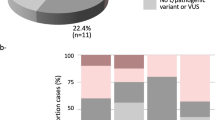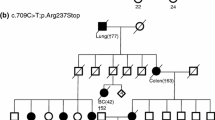Abstract
Germline mutations in BRCA1 and BRCA2 account for ~30 % of inherited breast cancer. RAD51C was reported as an additional breast/ovarian cancer susceptibility gene in some populations. There is a paucity of data on the putative contribution of this gene to inherited breast/ovarian cancer in Jewish high risk families. High risk Jewish women, none of whom was a carrier of the predominant Jewish mutations in BRCA1 or BRCA2, were screened for RAD51C germline mutations by direct sequencing of exons and flanking intronic sequences. Overall, 206 high risk women, 79 (38.3 %) of Ashkenazi origin, were genotyped for RAD51C mutations: 190 (92.3 %) with uni- or bilateral breast cancer (mean age at diagnosis 51.3 ± 11.1 years), 14 with ovarian cancer (mean age at diagnosis 55.6 ± 8.7 years), and two with both breast and ovarian cancer. No truncating mutations were noted, and two previously described missense mutations were detected: p.Ile144Thr and p.Thr287Ala in Iraqi and mixed ethnicity Balkan-North African participants, respectively. These missense mutations were evolutionarily conserved, possibly pathogenic, based on some prediction algorithms, and were not detected in any of healthy Iraqi (n = 60) and mixed ethnicity (n = 140), cancer free controls, respectively. Germline mutations in RAD51C contribute marginally to breast and ovarian cancer susceptibility in ethnically diverse, Jewish high risk families. The p.Thr287Ala missense mutation may be a recurring, pathogenic RAD51C mutation in ethnically diverse populations.
Similar content being viewed by others
References
Antoniou A, Pharoah PD, Narod S, Risch HA, Eyfjord JE, Hopper JL, Loman N, Olsson H, Johannsson O, Borg A, Pasini B, Radice P, Manoukian S, Eccles DM, Tang N, Olah E, Anton-Culver H, Warner E, Lubinski J, Gronwald J, Gorski B, Tulinius H, Thorlacius S, Eerola H, Nevanlinna H, Syrjäkoski K, Kallioniemi OP, Thompson D, Evans C, Peto J, Lalloo F, Evans DG, Easton DF (2003) Average risks of breast and ovarian cancer associated with BRCA1 or BRCA2 mutations detected in case Series unselected for family history: a combined analysis of 22 studies. Am J Hum Genet 72(5):1117–1130
Anglian Breast Cancer Study Group (2000) Prevalence and penetrance of BRCA1 and BRCA2 mutations in a population-based series of breast cancer cases. Br J Cancer 83:1301–1308
Irving M, Elmslie F, Berg J (2002) Genetics of breast cancer. Int J Clin Pract 56:677–682
Thompson D, Easton D (2004) The genetic epidemiology of breast cancer genes. J Mammary Gland Biol Neoplasia 9:221–236
Somyajit K, Subramanya S, Nagaraju G (2012) Distinct roles of FANCO/RAD51C protein in DNA damage signaling and repair: implications for Fanconi anemia and breast cancer susceptibility. J Biol Chem 287(5):3366–3380
Smeenk G, de Groot AJ, Romeijn RJ, van Buul PP, Zdzienicka MZ, Mullenders LH, Pastink A, Godthelp BC (2012) Rad51C is essential for embryonic development and haploinsufficiency causes increased DNA damage sensitivity and genomic instability. Mutat Res 689(1–2):50–58
Somyajit K, Subramanya S, Nagaraju G (2010) RAD51C: a novel cancer susceptibility gene is linked to Fanconi anemia and breast cancer. Carcinogenesis 31(12):2031–2038
Vaz F, Hanenberg H, Schuster B, Barker K, Wiek C, Erven V, Neveling K, Endt D, Kesterton I, Autore F, Fraternali F, Freund M, Hartmann L, Grimwade D, Roberts RG, Schaal H, Mohammed S, Rahman N, Schindler D, Mathew CG (2010) Mutation of the RAD51C gene in a Fanconi anemia-like disorder. Nat Genet 42:406–409
Meindl A, Hellebrand H, Wiek C, Erven V, Wappenschmidt B, Niederacher D, Freund M, Lichtner P, Hartmann L, Schaal H, Ramser J, Honisch E, Kubisch C, Wichmann HE, Kast K, Deissler H, Engel C, Müller-Myhsok B, Neveling K, Kiechle M, Mathew CG, Schindler D, Schmutzler RK, Hanenberg H (2010) Germline mutations in breast and ovarian cancer pedigrees establish RAD51C as a human cancer susceptibility gene. Nat Genet 42(5):410–414
Pelttari LM, Heikkinen T, Thompson D, Kallioniemi A, Schleutker J, Holli K, Blomqvist C, Aittomäki K, Bützow R, Nevanlinna H (2011) RAD51C is a susceptibility gene for ovarian cancer. Hum Mol Genet 20(16):3278–3288
Vuorela M, Pylkäs K, Hartikainen JM, Sundfeldt K, Lindblom A, von Wachenfeldt Wäppling A, Haanpää M, Puistola U, Rosengren A, Anttila M, Kosma VM, Mannermaa A, Winqvist R (2011) Further evidence for the contribution of the RAD51C gene in hereditary breast and ovarian cancer susceptibility. Breast Cancer Res Treat 130(3):1003–1010
Coulet F, Fajac A, Colas C, Eyries M, Dion-Minière A, Rouzier R, Uzan S, Lefranc JP, Carbonnel M, Cornelis F, Cortez A, Soubrier F (2012) Germline RAD51C mutations in ovarian cancer susceptibility. Clin Genet. doi:10.1111/j.1399-0004.2012.01917.x
Osorio A, Endt D, Fernández F, Eirich K, de la Hoya M, Schmutzler R, Caldés T, Meindl A, Schindler D, Benitez J (2012) Predominance of pathogenic missense variants in the RAD51C gene occurring in breast and ovarian cancer families. Hum Mol Genet 21(13):2889–2898
Romero A, Pérez-Segura P, Tosar A, García-Saenz JA, Díaz-Rubio E, Caldés T, de la Hoya M (2011) A HRM-based screening method detects RAD51C germ-line deleterious mutations in Spanish breast and ovarian cancer families. Breast Cancer Res Treat 129(3):939–946
Wong MW, Nordfors C, Mossman D, Pecenpetelovska G, Avery-Kiejda KA, Talseth-Palmer B, Bowden NA, Scott RJ (2011) BRIP1, PALB2, and RAD51C mutation analysis reveals their relative importance as genetic susceptibility factors for breast cancer. Breast Cancer Res Treat 127(3):853–859
Thompson ER, Boyle SE, Johnson J, Ryland GL, Sawyer S, Choong DY, kConFab, Chenevix-Trench G, Trainer AH, Lindeman GJ, Mitchell G, James PA, Campbell IG (2012) Analysis of RAD51C germline mutations in high-risk breast and ovarian cancer families and ovarian cancer patients. Hum Mutat 33(1):95–99
Pang Z, Yao L, Zhang J, Ouyang T, Li J, Wang T, Fan Z, Fan T, Lin B, Xie Y (2011) RAD51C germline mutations in Chinese women with familial breast cancer. Breast Cancer Res Treat 129(3):1019–1020
Lu W, Wang X, Lin H, Lindor NM, Couch FJ (2012) Mutation screening of RAD51C in high-risk breast and ovarian cancer families. Fam Cancer. [Epub Ahead of Print]
Clague J, Wilhoite G, Adamson A, Bailis A, Weitzel JN, Neuhausen SL (2011) RAD51C germline mutations in breast and ovarian cancer cases from high-risk families. PLoS One 6(9):e25632
Zheng Y, Zhang J, Hope K, Niu Q, Huo D, Olopade OI (2010) Screening RAD51C nucleotide alterations in patients with a family history of breast and ovarian cancer. Breast Cancer Res Treat 124(3):857–861
De Leeneer K, Van Bockstal M, De Brouwer S, Swietek N, Schietecatte P, Sabbaghian N, Van den Ende J, Willocx S, Storm K, Blaumeiser B, Van Asperen CJ, Wijnen JT, Leunen K, Legius E, Michils G, Matthijs G, Blok MJ, Gomez-Garcia E, De Paepe A, Tischkowitz M, Poppe B, Claes K (2012) Evaluation of RAD51C as cancer susceptibility gene in a large breast-ovarian cancer patient population referred for genetic testing. Breast Cancer Res Treat 133(1):393–398
Akbari MR, Tonin P, Foulkes WD, Ghadirian P, Tischkowitz M, Narod SA (2010) RAD51C germline mutations in breast and ovarian cancer patients. Breast Cancer Res 12(4):404
Rohlfs EM, Learning WG, Friedman KJ, Couch FJ, Weber BL, Silverman LM (1997) Direct detection of mutations in the breast and ovarian cancer susceptibility gene BRCA1 by PCR-mediated site-directed mutagenesis. Clin Chem 43:24–29
Laitman Y, Borsthein RT, Stoppa-Lyonnet D, Dagan E, Castera L, Goislard M, Gershoni-Baruch R, Goldberg H, Kaufman B, Ben-Baruch N, Zidan J, Maray T, Soussan-Gutman L, Friedman E (2011) Germline mutations in BRCA1 and BRCA2 genes in ethnically diverse high risk families in Israel. Breast Cancer Res Treat 127(2):489–495
Acknowledgments
We thank all individuals who participated to this study. This study was partially funded by the Israel Cancer Association. This work was done in partial fulfillment of the requirements for a Masters degree for Anya Kushnir at the Department of Human Genetics and Molecular Biology at the Tel-Aviv University, Tel-Aviv, Israel.
Conflict of interest
None.
Author information
Authors and Affiliations
Corresponding author
Rights and permissions
About this article
Cite this article
Kushnir, A., Laitman, Y., Shimon, S.P. et al. Germline mutations in RAD51C in Jewish high cancer risk families. Breast Cancer Res Treat 136, 869–874 (2012). https://doi.org/10.1007/s10549-012-2317-9
Received:
Accepted:
Published:
Issue Date:
DOI: https://doi.org/10.1007/s10549-012-2317-9




